Abstract
Cytochrome P450 (CYP) enzymes of the CYP101 and CYP111 families from Novosphingobium aromaticivorans are heme monooxygenases that catalyze the hydroxylation of a range of terpenoid compounds. CYP101D1 and CYP101D2 oxidized camphor to 5-exo-hydroxycamphor. CYP101B1 and CYP101C1 oxidized β-ionone to predominantly 3-R-hydroxy-β-ionone and 4-hydroxy-β-ionone, respectively. CYP111A2 oxidized linalool to 8-hydroxylinalool. Physiologically, these CYP enzymes could receive electrons from Arx, a [2Fe-2S] ferredoxin equivalent to putidaredoxin from the CYP101A1 system from Pseudomonas putida. A putative ferredoxin reductase (ArR) in the N. aromaticivorans genome, with high amino acid sequence homology to putidaredoxin reductase, has been over-produced in Escherichia coli and found to support substrate oxidation by these CYP enzymes via Arx with both high activity and coupling of product formation to NADH consumption. The ArR/Arx electron-transport chain has been co-expressed with the CYP enzymes in an E. coli host to provide in vivo whole-cell substrate oxidation systems that could produce up to 6.0 g L−1 of 5-exo-hydroxycamphor at rates of up to 64 μM (gram of cell dry weight)−1 min−1. These efficient biocatalytic systems have potential uses in preparative scale whole-cell biotransformations.






Similar content being viewed by others
References
Agematu H, Matsumoto N, Fujii Y, Kabumoto H, Doi S, Machida K, Ishikawa J, Arisawa A (2006) Hydroxylation of testosterone by bacterial cytochromes P450 using the Escherichia coli expression system. Biosci Biotechnol Biochem 70:307–311
Basta T, Buerger S, Stolz A (2005) Structural and replicative diversity of large plasmids from sphingomonads that degrade polycyclic aromatic compounds and xenobiotics. Microbiology 151:2025–2037
Bell SG, Wong LL (2007) P450 enzymes from the bacterium Novosphingobium aromaticivorans. Biochem Biophys Res Commun 360:666–672
Bell SG, Harford-Cross CF, Wong L-L (2001) Engineering the CYP101 system for in vivo oxidation of unnatural substrates. Protein Eng 14:797–802
Bell SG, Xu F, Forward I, Bartlam M, Rao Z, Wong LL (2008) Crystal structure of CYP199A2, a para-substituted benzoic acid oxidizing cytochrome P450 from Rhodopseudomonas palustris. J Mol Biol 383:561–574
Bell SG, Tan ABH, Johnson EOD, Wong LL (2009) Selective oxidative demethylation of veratric acid to vanillic acid by CYP199A4 from Rhodopseudomonas palustris HaA2. Mol Biosyst. doi:10.1039
Bernhardt R (2006) Cytochromes P450 as versatile biocatalysts. J Biotechnol 124:128–145
Bernhardt R, Gunsalus IC (1992) Reconstitution of cytochrome P4502B4 (LM2) activity with camphor and linalool monooxygenase electron donors. Biochem Biophys Res Commun 187:310–317
Blair DE, Diehl H (1961) Sulfonic acid derivatives of 1, 10-phenanthroline. Anal Chem 33:867–870
Bogdanos DP, Vergani D (2009) Bacteria and primary biliary cirrhosis. Clin Rev Allergy Immunol 36:30–39
Carugo O, Argos P (1997) NADP-dependent enzymes. I: Conserved stereochemistry of cofactor binding. Proteins 28:10–28
Chefson A, Auclair K (2006) Progress towards the easier use of P450 enzymes. Mol Biosyst 2:462–469
Chun YJ, Shimada T, Sanchez-Ponce R, Martin MV, Lei L, Zhao B, Kelly SL, Waterman MR, Lamb DC, Guengerich FP (2007) Electron transport pathway for a streptomyces cytochrome P450: cytochrome P450 105D5-catalyzed fatty acid hydroxylation in Streptomyces coelicolor A3(2). J Biol Chem 282:17486–17500
Copeland ALS, Lapidus A, Barry K, Detter JC, Glavina T, Hammon N, Israni S, Pitluck S, Chain P, Malfatti S, Shin M, Vergez L, Schmutz J, Larimer F, Land M, Kyrpides N, Ivanova N, Fredrickson J, Balkwill D, Romine MF, Richardson P (2006). Complete sequence of Novosphingobium aromaticivorans DSM 12444. http://genome.jgi-psf.org/novar/novar.home.html. Accessed 14 Aug 2009
Cryle MJ, Stok JE, De Voss JJ (2003) Reactions catalyzed by bacterial cytochromes P450. Aust J Chem 56:749–762
Cuvigny T (1988) Alkylation of linalool at carbon-8 (and carbon-6). J Organomet Chem 344:9–28
Fredrickson JK, Brockman FJ, Workman DJ, Li SW, Stevens TO (1991) Isolation and characterization of a subsurface bacterium capable of growth on toluene, naphthalene, and other aromatic compounds. Appl Environ Microbiol 57:796–803
Fredrickson JK, Balkwill DL, Romine MF, Shi T (1999) Ecology, physiology, and phylogeny of deep subsurface Sphingomonas sp. J Ind Microbiol Biotechnol 23:273–283
Gillam EM, Aguinaldo AM, Notley LM, Kim D, Mundkowski RG, Volkov AA, Arnold FH, Soucek P, DeVoss JJ, Guengerich FP (1999) Formation of indigo by recombinant mammalian cytochrome P450. Biochem Biophys Res Commun 265:469–472
Guengerich FP (2001a) Common and uncommon cytochrome P450 reactions related to metabolism and chemical toxicity. Chem Res Toxicol 14:611–650
Guengerich FP (2001b) Uncommon P450-catalyzed reactions. Curr Drug Metab 2:93–115
Hannemann F, Bichet A, Ewen KM, Bernhardt R (2007) Cytochrome P450 systems-biological variations of electron transport chains. Biochim Biophys Acta 1770:330–344
Hawkes DB, Adams GW, Burlingame AL, Ortiz de Montellano PR, de Voss JJ (2002) Cytochrome P450cin (CYP176A), isolation, expression, and characterization. J Biol Chem 277:27725–27732
Isin EM, Guengerich FP (2007) Complex reactions catalyzed by cytochrome P450 enzymes. Biochim Biophys Acta 1770:314–329
Janikowski TB, Velicogna D, Punt M, Daugulis AJ (2002) Use of a two-phase partitioning bioreactor for degrading polycyclic aromatic hydrocarbons by a Sphingomonas sp. Appl Microbiol Biotechnol 59:368–376
Julsing MK, Cornelissen S, Buhler B, Schmid A (2008) Heme-iron oxygenases: powerful industrial biocatalysts? Curr Opin Chem Biol 12:177–186
Kim D, Ortiz de Montellano PR (2009) Tricistronic overexpression of cytochrome P450cam, putidaredoxin, and putidaredoxin reductase provides a useful cell-based catalytic system. Biotechnol Lett 31:1427–1431
Koga H, Yamaguchi E, Matsunaga K, Aramaki H, Horiuchi T (1989) Cloning and nucleotide sequences of NADH-putidaredoxin reductase gene (camA) and putidaredoxin gene (camB) involved in cytochrome P-450cam hydroxylase of Pseudomonas putida. J Biochem (Tokyo) 106:831–836
Maurer SC, Kuhnel K, Kaysser LA, Eiben S, Schmid RD, Urlacher VB (2005) Catalytic hydroxylation in biphasic systems using CYP102A1 mutants. Adv Synth Catal 347:1090–1098
Meyer D, Buhler B, Schmid A (2006) Process and catalyst design objectives for specific redox biocatalysis. Adv Appl Microbiol 59:53–91
Momoi K, Hofmann U, Schmid RD, Urlacher VB (2006) Reconstitution of beta-carotene hydroxylase activity of thermostable CYP175A1 monooxygenase. Biochem Biophys Res Commun 339:331–336
Morrish JL, Brennan ET, Dry HC, Daugulis AJ (2008) Enhanced bioproduction of carvone in a two-liquid-phase partitioning bioreactor with a highly hydrophobic biocatalyst. Biotechnol Bioeng 101:768–775
Moulis JM, Meyer J (1982) Characterization of the selenium-substituted 2 [4Fe-4Se] ferredoxin from Clostridium pasteurianum. Biochemistry 21:4762–4771
Mouri T, Michizoe J, Ichinose H, Kamiya N, Goto M (2006) A recombinant Escherichia coli whole cell biocatalyst harboring a cytochrome P450cam monooxygenase system coupled with enzymatic cofactor regeneration. Appl Microbiol Biotechnol 72:514–520
Munro AW, Girvan HM, McLean KJ (2007a) Cytochrome P450-redox partner fusion enzymes. Biochim Biophys Acta 1770:345–359
Munro AW, Girvan HM, McLean KJ (2007b) Variations on a (t)heme-novel mechanisms, redox partners and catalytic functions in the cytochrome P450 superfamily. Nat Prod Rep 24:585–609
Omura T, Sato R (1964) The carbon monoxide-binding pigment of liver micorsomes. J Biol Chem 239:2370–2378
Ortiz de Montellano PR (ed) (2005) Cytochrome P450: structure, mechanism, and biochemistry. Kluwer Academic/Plenum Publishers, New York
Parajuli N, Basnet DB, Lee HC, Sohng JK, Liou K (2004) Genome analyses of Streptomyces peucetius ATCC 27952 for the identification and comparison of cytochrome P450 complement with other Streptomyces. Arch Biochem Biophys 425:233–241
Peterson JA, Lorence MC, Amarneh B (1990) Putidaredoxin reductase and putidaredoxin - cloning, sequence determination, and heterologous expression of the proteins. J Biol Chem 265:6066–6073
Peterson JA, Lu JY, Geisselsoder J, Graham-Lorence S, Carmona C, Witney F, Lorence MC (1992) Cytochrome P-450terp. Isolation and purification of the protein and cloning and sequencing of its operon. J Biol Chem 267:14193–14203
Pinyakong O, Habe H, Omori T (2003) The unique aromatic catabolic genes in sphingomonads degrading polycyclic aromatic hydrocarbons (PAHs). J Gen Appl Microbiol 49:1–19
Robin A, Roberts GA, Kisch J, Sabbadin F, Grogan G, Bruce N, Turner NJ, Flitsch SL (2009) Engineering and improvement of the efficiency of a chimeric [P450cam-RhFRed reductase domain] enzyme. Chem Commun 18:2478–2480
Romine MF, Fredrickson JK, Li SM (1999a) Induction of aromatic catabolic activity in Sphingomonas aromaticivorans strain F199. J Ind Microbiol Biotechnol 23:303–313
Romine MF, Stillwell LC, Wong KK, Thurston SJ, Sisk EC, Sensen C, Gaasterland T, Fredrickson JK, Saffer JD (1999b) Complete sequence of a 184-kilobase catabolic plasmid from Sphingomonas aromaticivorans F199. J Bacteriol 181:1585–1602
Ropp JD, Gunsalus IC, Sligar SG (1993) Cloning and expression of a member of a new cytochrome P-450 family: cytochrome P-450lin (CYP111) from Pseudomonas incognita. J Bacteriol 175:6028–6037
Schewe H, Holtmann D, Schrader J (2009) P450BM-3-catalyzed whole-cell biotransformation of alpha-pinene with recombinant Escherichia coli in an aqueous-organic two-phase system. Appl Microbiol Biotechnol 83:849–857
Selmi C, Gershwin ME (2004) Bacteria and human autoimmunity: the case of primary biliary cirrhosis. Curr Opin Rheumatol 16:406–410
Shi T, Fredrickson JK, Balkwill DL (2001) Biodegradation of polycyclic aromatic hydrocarbons by Sphingomonas strains isolated from the terrestrial subsurface. J Ind Microbiol Biotechnol 26:283–289
Sibbesen O, De Voss JJ, Montellano PR (1996) Putidaredoxin reductase-putidaredoxin-cytochrome p450cam triple fusion protein. Construction of a self-sufficient Escherichia coli catalytic system. J Biol Chem 271:22462–22469
Sigel A, Sigel H, Sigel R (2007) The ubiquitous roles of cytochrome P450 proteins. John Wiley & Sons, Chichester
Ullah AJ, Murray RI, Bhattacharyya PK, Wagner GC, Gunsalus IC (1990) Protein components of a cytochrome P-450 linalool 8-methyl hydroxylase. J Biol Chem 265:1345–1351
Urlacher VB, Makhsumkhanov A, Schmid RD (2006) Biotransformation of beta-ionone by engineered cytochrome P450 BM-3. Appl Microbiol Biotechnol 70:53–59
van Beilen JB, Funhoff EG, van Loon A, Just A, Kaysser L, Bouza M, Holtackers R, Rothlisberger M, Li Z, Witholt B (2006) Cytochrome P450 alkane hydroxylases of the CYP153 family are common in alkane-degrading eubacteria lacking integral membrane alkane hydroxylases. Appl Environ Microbiol 72:59–65
Westlake AC, Harford-Cross CF, Donovan J, Wong LL (1999) Mutations of glutamate-84 at the putative potassium-binding site affect camphor binding and oxidation by cytochrome p450cam. Eur J Biochem 265:929–935
Williams JW, Morrison JF (1979) The kinetics of reversible tight-binding inhibition. Methods Enzymol 63:437–467
Xu F, Bell SG, Peng Y, Johnson EOD, Bartlam M, Rao Z, Wong LL (2009) Crystal structure of a ferredoxin reductase for the CYP199A2 system from Rhodopseudomonas palustris. Proteins: Struct Funct Bioinf. doi:10.1002/prot.22510
Zotchev SB, Hutchinson CR (1995) Cloning and heterologous expression of the genes encoding nonspecific electron-transport components for a cytochrome-P450 system of Saccharopolyspora erythraea involved in erythromycin production. Gene 156:101–106
Acknowledgements
This work was supported by the Higher Education Funding Council for England.
Author information
Authors and Affiliations
Corresponding author
Electronic supplementary material
Below is the link to the electronic supplementary material.
ESM 1
Supplementary data. (DOC 152 kb)
Rights and permissions
About this article
Cite this article
Bell, S.G., Dale, A., Rees, N.H. et al. A cytochrome P450 class I electron transfer system from Novosphingobium aromaticivorans . Appl Microbiol Biotechnol 86, 163–175 (2010). https://doi.org/10.1007/s00253-009-2234-y
Received:
Revised:
Accepted:
Published:
Issue Date:
DOI: https://doi.org/10.1007/s00253-009-2234-y




